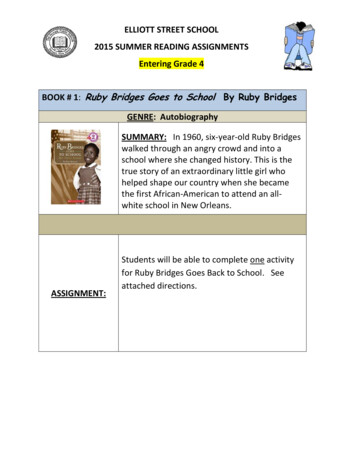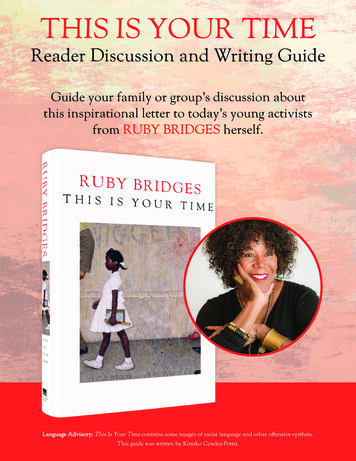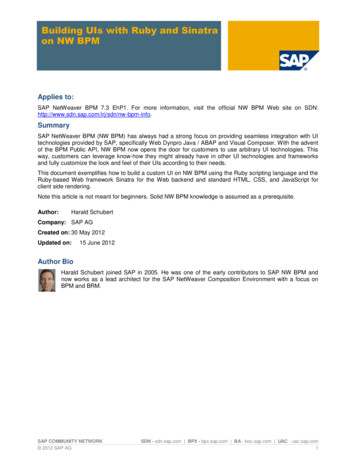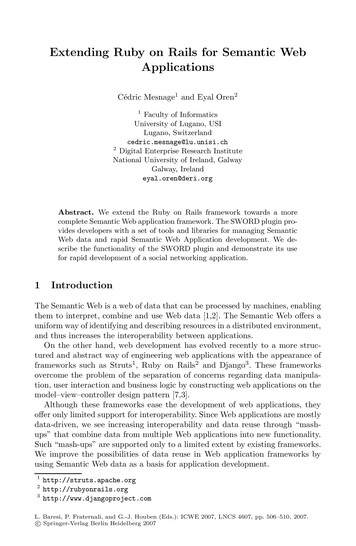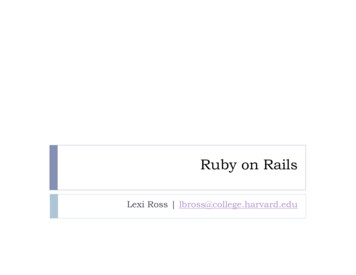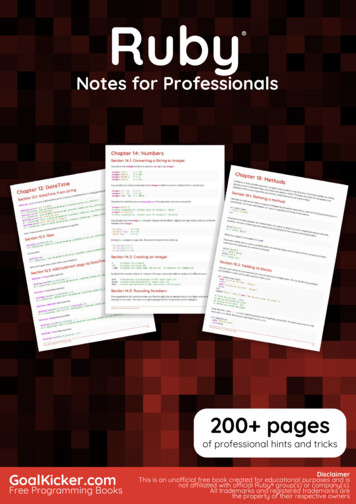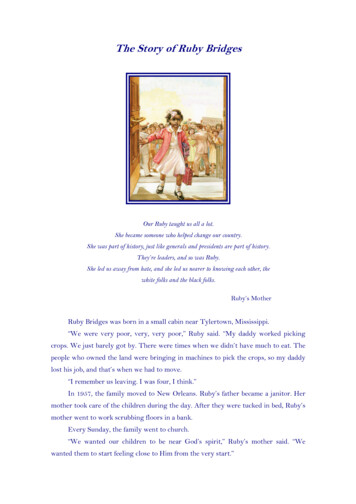
Transcription
The Story of Ruby BridgesOur Ruby taught us all a lot.She became someone who helped change our country.She was part of history, just like generals and presidents are part of history.They’re leaders, and so was Ruby.She led us away from hate, and she led us nearer to knowing each other, thewhite folks and the black folks.Ruby’s MotherRuby Bridges was born in a small cabin near Tylertown, Mississippi.“We were very poor, very, very poor,” Ruby said. “My daddy worked pickingcrops. We just barely got by. There were times when we didn’t have much to eat. Thepeople who owned the land were bringing in machines to pick the crops, so my daddylost his job, and that’s when we had to move.“I remember us leaving. I was four, I think.”In 1957, the family moved to New Orleans. Ruby’s father became a janitor. Hermother took care of the children during the day. After they were tucked in bed, Ruby’smother went to work scrubbing floors in a bank.Every Sunday, the family went to church.“We wanted our children to be near God’s spirit,” Ruby’s mother said. “Wewanted them to start feeling close to Him from the very start.”
At that time, black children and white children went to separate schools in NewOrleans. The black children were not able to receive the same education as the whitechildren. It wasn’t fair. And it was against the nation’s law.In 1960, a judge ordered four black girls to go to two white elementary schools.Three of the girls were sent to McDonogh 19. Six-year-old Ruby Bridges was sent tofirst grade in the William Frantz Elementary School.Ruby’s parents were proud that their daughter had been chosen to take part inan important event in American history. They went to church.“We sat there and prayed to God,” Ruby’s mother said, “that we’d all be strongand we’d have courage and we’d get through any trouble; and Ruby would be a goodgirl and she’d hold her head up high and be a credit to her own people and a credit toall the American people. We prayed long and we prayed hard.”On Ruby’s first day, a large crowd of angry white people gathered outside theFrantz Elementary School. The people carried signs that said they didn’t want blackchildren in a white school. People called Ruby names; some wanted to hurt her. Thecity and state police did not help Ruby.The President of the United States ordered federal marshals to walk with Rubyinto the school building. The marshals carried guns.Every day, for weeks that turned into months, Ruby experienced that kind ofschool day.She walked to the Frantz School surrounded by marshals. Wearing a clean dressand a bow in her hair and carrying her lunch pail, Ruby walked slowly for the first fewblocks. As Ruby approached the school, she saw a crowd of people marching up anddown the street. Men and women and children shouted at her. They pushed towardher. The marshals kept them from Ruby by threatening to arrest them.
Ruby would hurry through the crowd and not say a word.The white people in the neighborhood would not send their children to school.When Ruby got inside the building, she was all alone except for her teacher, Mrs.Henry. There were no other children to keep Ruby company, to play with and learnwith, to eat lunch with.But every day, Ruby went into the classroom with a big smile on her face, readyto get down to the business of learning.“She was polite and she worked well at her desk,” Mrs. Henry said. “She enjoyedher time there. She didn’t seem nervous or anxious or irritable or scared. She seemedas normal and relaxed as any child I’ve ever taught.”So Ruby began learning how to read and write in an empty classroom, an emptybuilding.“Sometimes I’d look at her and wonder how she did it,” said Mrs. Henry. “Howshe went by those mobs and sat here all by herself and yet seemed so relaxed andcomfortable.”Mrs. Henry would question Ruby in order to find out if the girl was reallynervous and afraid even though she seemed so calm and confident. But Ruby keptsaying she was doing fine.The teacher decided to wait and see if Ruby would keep on being so relaxed andhopeful or if she’d gradually begin to wear down — or even decide that she no longerwanted to go to school.Then one morning, something happened. Mrs. Henry stood by a window in herclassroom as she usually did, watching Ruby walk toward the school. Suddenly, Rubystopped — right in front of the mob of howling and screaming people. She stood therefacing all those men and women. She seemed to be talking to them.
Mrs. Henry saw Ruby’s lips moving and wondered what Ruby could be saying.The crowd seemed ready to kill her.The marshals were frightened. They tried to persuade Ruby to move along.They tried to hurry her into the school, but Ruby wouldn’t budge.Then Ruby stopped talking and walked into the school.When she went into the classroom, Mrs. Henry asked her what happened. Mrs.Henry told Ruby that she’d been watching and that she was surprised when Rubystopped and talked with the people in the mob.Ruby became irritated.“I didn’t stop and talk with them,” she said.“Ruby, I saw you talking,” Mrs. Henry said. “I saw your lips moving.”“I wasn’t talking,” said Ruby “I was praying. I was praying for them.”Every morning, Ruby had stopped a few blocks away from school to say a prayerfor the people who hated her. This morning she forgot until she was already in themiddle of the angry mob.When school was over for the day, Ruby hurried through the mob as usual. Aftershe walked a few blocks and the crowd was behind her, Ruby said the prayer sherepeated twice a day — before and after school:Please, God, try to forgive those people.Because even if they say those bad things,They don’t know what they’re doing.So You could forgive them,Just like You did those folks a long time agoWhen they said terrible things about You.
AFTERWORDLater that year, two white boys joined Ruby at the Frantz Elementary School Theirparents were tired of seeing the boys get into mischief around the house when they could havebeen in school and learning. The mob became very angry when the first white boys went backto school. But those boys were soon joined by other children.“We’ve been sitting back and letting our children get cheated out of an educationbecause some people have tried to take the law into their own hands,” one parent said. “It’stime for us to fight for the side of the law and for our children’s right to go to a school and gettheir education.”They all did get their education, Ruby and a growing number of boys and girls whowent to school with her. By the time Ruby was in the second grade, the mobs had given uptheir struggle to scare Ruby and defeat the federal judge’s order that New Orleans schools bedesegregated so that children of all races might be in the same classroom. Year after year,Ruby went to the Frantz School She graduated from it, then went on to graduate from highschool.Ruby Bridges is married to a building contractor and has four sons who attend schoolwithin the New Orleans Public School System. Now a successful businesswoman, she hascreated the Ruby Bridges Educational Foundation for the purpose of increasing parentalinvolvement in schools.Robert Coles; George FordThe Story of Ruby BridgesNew York, Scholastic, Inc., 2004
By the time Ruby was in the second grade, the mobs had given up their struggle to scare Ruby and defeat the federal judge’s order that New Orleans schools be desegregated so that children of all races might be in the same classroom. Year after year, Ruby went to the Frantz School She grad
